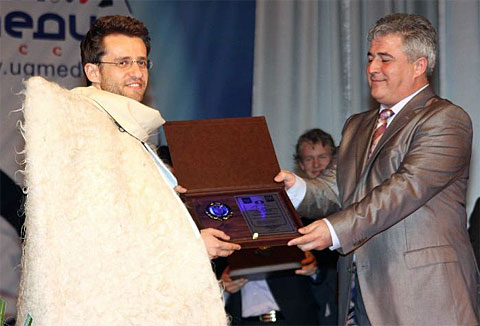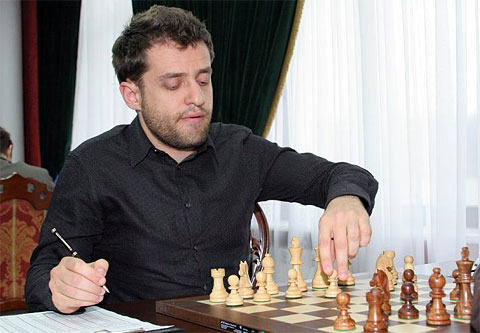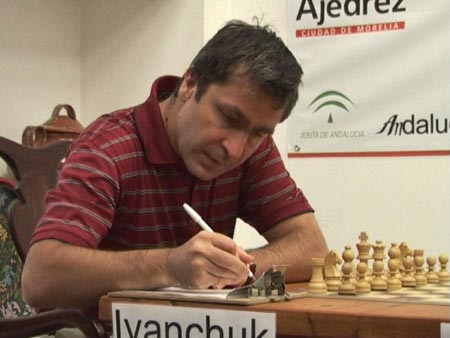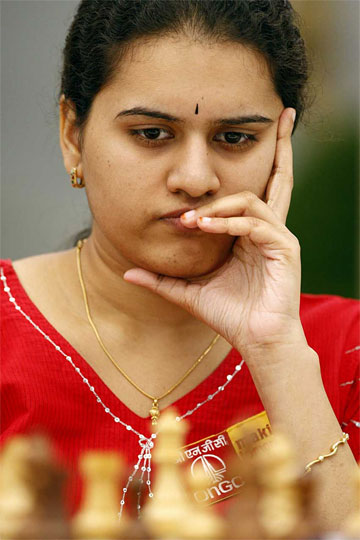| Latest | Greatest | Lobby | Journals | Search | Options | Help | Login |
|
|
|
This topic is archived. |
| Home » Discuss » Topic Forums » Sports |
|
| Jack Rabbit
|
Sat May-02-09 06:37 PM Original message |
| The JR Chess Report (May 2): Aronian Wins GP with Dramatic Victory in Final Round |
|
Aronian Wins GP with Dramatic Victory in Final Round
 Armenian grandmaster Levon Aronian took a clear first place in the Nalchik Grand Prix when he defeated his closest rival, former challenger for the world title Peter Leko of Hungary, in the 13th and final round Wednesday. Aronian and Leko entered the final round tied for first place with 7� points each. The day before, Leko defeated Uzbek GM Rustam Kasimdzhanov to move into a tie with Aronian, who drew his twelfth round game with Russo-American GM Gata Kamsky, to set up the showdown. Aronian played White in the final round. Both competitors were clearly playing for a win, taking risks when the opportunity presented itself. Aronian started pressing his advantage with an exchange sacrifice on his 34th move; on move 54, Aronian offered to trade Queens and sacrifice his kast remaining piece, a Bishop, with check, which would have left him with two advancing passed pawns, one already on the seventh rank, which Leko's remaining Rook could not stop from promoting. Leko resigned rather than continue a lost cause. (See the game below.) Being that the Grand Prix is a round robin tournament, the last round pairing was purely coincidnetal, having been decided by drawing lots two weeks ago before the first round. In Swiss system events, such last round showdowns are common. Aronian's compatriot, Vladimir Akopian, who started the tournament badly with two losses in the fisrt three rounds, roared back to finish tied with Leko for second when he won his final game with Black against Ukrainian GM Pavel Eljanov. Eight tied for first after 7 rounds in Dubai  The eleventh annual Dubai Open staged its sixth and seventh rounds of a scheduled nine today with eight palyers ending the action tied for first place. Among those at the top is Azerbaijani GM Gadir Guseinov, the tournament's top seed, Valim Malakhatko of Belgium by way of Ukraine, the number three seed, Armenia's Tigran Kotanjian, re-entering first palce after being there after round four but dropping out of it after losing in round five, and Levan Pantsulaia of Georgia, a former Dubai champion. The tournament continues tomorrow with live games broadcast on the website of the Dubai Chess and Culture Club starting at 5:30 pm in Dubai (6:30 am in California). The last round is scheduled for Monday. Calendar US Chess Championship, St. Louis 7-17 May. Bosna 2009, Sarajevo 8-18 May MTel Masters, Sofia 12-23 May. Asian Championships, Subic Freeport (The Philippines) 12-23 May. Chicago Open 22-25 May. Aerosvit International Tournament, Foros (Ukraine) 9-20 June. World Open, Philadelphia 29 June-5 July. Sparkassen Chess Meeting, Dortmund 2-12 July. San Sebastian International Tournament 6-16 July. Former world champion Karpov is among the participants. Canadian Open, Edmonton 11-19 July. Czech Open, Pardubice 16 July-2 August. Biel Chess Festival 19-30 July. This year's GM Tournament is a Category 19 that includes Morozevich, Ivanchuk, Gelfand, Alekseev, Vachier Lagrave and Caruana. Mainz Chess Classic 27 July-2 August. FIDE Grand Prix, Yerevan 8-24 August. World Junior Championship, Mar del Plata (Argentina) 16-29 October. World Cup, Khanty Mansiysk 28 November-15 December |
| Printer Friendly | Permalink | | Top |
| Jack Rabbit
|
Sat May-02-09 06:39 PM Response to Original message |
| 1. This Week's Games |
|
Your humble hare acknowledges the assistance of Fritz 6.0 on analysis. Diagrams on the Jack Rabbit Chess Report are made with Chess M�rida, a true type font that can be downlaoded free here. !""""""""# $tMvWlVmT% $OoOoOoOo% $ + + + +% $+ + + + % $ + + + +% $+ + + + % $pPpPpPpP% $RnBqKbNr% /(((((((() WHITE White to move (This position is a theoretical draw) |
| Printer Friendly | Permalink | | Top |
| Jack Rabbit
|
Sat May-02-09 06:42 PM Response to Reply #1 |
| 2. FIDE Grand Prix, Nalchik |
| Printer Friendly | Permalink | | Top |
| Jack Rabbit
|
Sat May-02-09 06:43 PM Response to Reply #2 |
| 3. Aronian - Leko, Round 13 |
 Levon Aronian, in a Caucasian cloak, receives his tropies during the closing ceremonies in Nalchik Levon Aronian - Peter Leko FIDE Grand Prix, Round 13 Nalchik, 29 April 2009 East India Game: Nimzo-Indian Defense (Gligoric Opening) 1.d4 Nf6 2.c4 e6 3.Nc3 Bb4 4.e3 0-0 5.Bd3
5...d5 6.Nf3 c5 7.0-0 dxc4
8.Bxc4 Nbd7 9.Qe2
9...b6 10.Rd1
10...cxd4 11.exd4 Bxc3
12.bxc3 Bb7 13.Bb3!?
13...Qc7
14.c4 Rfe8
15.Bb2 Qf4!?
16.Qe3 Qf5
17.Ne1 b5!?
!""""""""# $t+ +t+l+% $Ov+m+oOo% $ + +oM +% $+o+ +w+ % $ +pP + +% $+b+ Q + % $pB + PpP% $R +rN K % /(((((((() WHITE: Levon Aronian Position after 17...b6b5 18.c5!
18...Nd5 19.Qg3 Nf4 20.Rd2 Nf6 21.f3 N6h5 22.Qf2
22...Bd5
23.Bc2 Qg5
24.Kh1 Bc4 25.g3 Ng6
26.Ng2 Bd5 27.Ne3 Nf6 28.h4
28...Qh5 29.Nxd5 Nxd5 30.Re1
30...Red8 31.Rde2 Rab8 32.Bc1 h6 33.Kg2 Nc3
!""""""""# $ T T +l+% $O + +oO % $ + +o+mO% $+oP + +w% $ + P + P% $+ M +pP % $p+b+rQk+% $+ B R + % /(((((((() WHITE: Levon Aronian Position after 33...Nd4c3 34.Re5!!
34...Nxe5 35.Rxe5 f5 36.Bb3!?
36...Nd5!
37.Rxe6!
37...Kh8?
38.Qe1!
38...Nf6
39.Qe5 Re8 !""""""""# $ T +t+ L% $O + + O % $ + +tM O% $+oP Qo+w% $ + P + P% $+b+ +pP % $o+ + +k+% $+ B + + % /(((((((() WHITE: Levon Aronian Position after 39...Rd8e8 40.c6!
40...Rbc8 41.Qxb5 Qg6 42.h5!?
42...Qxh5 43.Bf4!
43...a6
44.Qxa6 Nh7
!""""""""# $ +t+t+ L% $+ + + Om% $q+p+r+ O% $+ + +o+w% $ + P B +% $+b+ +pP % $p+ + +k+% $+ + + + % /(((((((() WHITE: Levon Aronian Position after 44...Nf6h7 45.c7! Ng5 46.Rxe8+ Qxe8 47.d5 Ra8 48.Qc4
48...Kh7 49.d6 Qe1
50.Qf1 Qe8 51.Qd3 Qd7 52.Qc4 Qe8
53.Bxg5
53...hxg5 !""""""""# $t+ +w+ +% $+ P + Ol% $ + P + +% $+ + +oO % $ +q+ + +% $+b+ +pP % $o+ + +k+% $+ + + + % /(((((((() WHITE: Levon Aronian Position after 53...hg5:B 54.Qg8+!! 1-0
|
| Printer Friendly | Permalink | | Top |
| Jack Rabbit
|
Sat May-02-09 06:47 PM Response to Reply #2 |
| 5. Aronian - Eljanov, Round 10 |
 Levon Aronian Levon Aronian - Pavel Eljanov FIDE Grand Prix, Round 10 Nalchik, 26 April 2009 Orthodox Queen's Gambit: Blackburne Opening 1.Nf3 Nf6 2.c4 e6 3.d4 d5 4.Nc3 Nbd7 5.Bf4 Bb4 6.cxd5
6...exd5 7.Qb3
7...c5 8.dxc5 Qa5 9.a3 Bxc3+ 10.bxc3
10...Qxc5 11.Qb4!?
11...Ne4
12.Nd4 b6!?
13.f3 a5
14.Qxc5 Nexc5 15.Nf5
15...Ne6
16.Bg3 g6 17.Nd6+ Ke7 18.e3!?
18...Rd8!
19.Rb1 Ba6 20.Kf2 f5 21.Nb5 Rdc8 22.Be2
22...Bxb5 23.Rxb5 Rxc3 24.Rxd5 Nf6?!
!""""""""# $t+ + + +% $+ + L +o% $ O +mMo+% $O +r+o+ % $ + + + +% $P T PpB % $ + +bKpP% $+ + + +r% /(((((((() WHITE: Levon Aronian Position after 24...Nd7f6 25.Rd2
25...Nc5 26.Rb1 Nfe4+
27.fxe4 Nxe4+ 28.Ke1 Nxd2 29.Kxd2
29...Rxa3 30.Bh4+ Kf7?!
31.Bc4+ Kg7 32.Rxb6 Ra4 !""""""""# $t+ + + +% $+ + + Lo% $ R + +o+% $P + +o+ % $t+b+ + B% $+ + P + % $ + K +pP% $+ + + + % /(((((((() WHITE: Levon Aronian Position after 32...Ra3a4 33.Bf6+!
33...Kh6 34.Rc6 Ra7 35.h4!?
35...Kh5?
36.Ke1 Rb7
37.Kf2 Rab4
38.Bg5 Rb2+
!""""""""# $ + + + +% $+t+ + +o% $ + + +o+% $O + +oBl% $ +b+ + P% $+ + P + % $ T + Kp+% $+ + + + % /(((((((() WHITE: Levon Aronian Position after 38...Rb7b2+ 39.Be2+!
39...Rxe2+ 40.Kxe2 Kg4 41.Kf2 Rb2+ 42.Kg1
42...Kg3 43.Bf4+ Kxh4 44.Rc7 h5 45.Rc4 Rb4 46.Rd4 g5 47.Bd6+!
47...Rxd4 48.exd4 Kg4 49.d5 f4 50.Bxf4 1-0
|
| Printer Friendly | Permalink | | Top |
| Jack Rabbit
|
Sat May-02-09 06:49 PM Response to Reply #2 |
| 6. Leko - Gelfand, Round 10 |
 Peter Leko Peter Leko - Boris Gelfand FIDE Grand Prix, Round 10 Nalchik, 26 April 2009 Epine Dorsal: Horseman Defense (Jaenisch Opening) (Petroff Defense) 1.e4 e5 2.Nf3 Nf6 3.Nxe5 d6 4.Nf3 Nxe4 5.d4 d5 6.Bd3 Nc6 7.0-0 Be7 8.Re1
8...Bg4 9.c4
9...Nf6 10.Nc3
10...Bxf3
11.Qxf3 Nxd4 12.Qd1 Ne6 13.cxd5
13...Nxd5 14.Bb5+ c6 15.Nxd5 cxb5 16.Qb3 0-0 17.Be3!?
17...Bc5!?
!""""""""# $t+ W Tl+% $Oo+ +oOo% $ + +m+ +% $+oVn+ + % $ + + + +% $+q+ B + % $pP + PpP% $R + R K % /(((((((() WHITE: Peter Leko Position after 17...Be7c5 18.Rad1!
18...Bxe3 19.Rxe3
19...Qa5 20.Qc2 Rfe8 21.f4!?
21...b4
22.f5 Nf8 23.Red3
23...Nd7 24.Qc7 Qc5+ 25.Kf1 Qb5
26.Qg3!
26...Ne5?
!""""""""# $t+ +t+l+% $OoQn+oOo% $ + + + +% $+w+n+p+ % $ O + + +% $+ + R + % $pP + +pP% $+ +r+k+ % /(((((((() WHITE: Peter Leko Position after 26...Nd7e5 27.f6!
27...g6
28.Qg5 Kh8 29.Qh6 Rg8
!""""""""# $t+ + +tL% $Oo+ +o+o% $ + + PoQ% $+w+nM + % $ O + + +% $+ +r+ + % $pP + +pP% $+ +r+k+ % /(((((((() WHITE: Peter Leko Position after 29...Re8g8 30.Nc7!
30...Qc4
31.b3 Qg4
32.Rd4 Qf5+ 33.Rf4 Ng4
34.Qg7+ Rxg7 35.fxg7+ Kxg7 36.Rxf5 gxf5 37.Nxa8
37...Ne3+ 38.Ke2 Nxd1 39.Kxd1
39...Kf6 40.Kd2 Ke5 41.Nc7 f4 42.Kd3 a6 43.Na8
|
| Printer Friendly | Permalink | | Top |
| Jack Rabbit
|
Sat May-02-09 06:51 PM Response to Reply #2 |
| 7. Ivanchuk - Grischuk, Round 11 |
|
Ivanchuk would probably like to forget Nalchik, but his only victory all but knocked Grischuk out of contention.
 Vassily Ivanchuk Vassily Ivanchuk - Alexander Grischuk FIDE Grand Prix, Round 11 Nalchik, 27 April 2009 West India Game: King's Indian Defense (Main Line/Aronin Variation) 1.d4 Nf6 2.c4 g6 3.Nc3 Bg7 4.e4 d6 5.Nf3 0-0 6.Be2 e5 7.0-0 Nc6
8.d5
8...Ne7 9.b4
9...Nh5
10.c5
10...Nf4 11.Bxf4 exf4 12.Rc1 h6 13.Nd4
13...a6!?
14.h3
14...Kh8 15.Qd2 Ng8!?
16.Rfd1!
16...h5
17.Qxf4!?
17...Bh6
18.Qg3 h4 19.Qd3 Bxc1
20.Rxc1 Qg5 21.Re1
!""""""""# $t+v+ TmL% $+oO +o+ % $o+ O +o+% $+ PP+ W % $ P Np+ O% $+ Nq+ +p% $p+ +bPp+% $+ + R K % /(((((((() WHITE: Vassily Ivanchuk Position after 21.Rc1e1 21...Bd7!
22.c6 bxc6 23.dxc6 Be6!
24.Bg4
24...Bxg4
25.hxg4 Ne7 26.Qd1
26...Rab8 27.a3 Kg7 28.Re3 Qf6 29.Nf3 Nxc6?
30.Nd5!
30...Qe6 31.Nxc7 Qxg4
!""""""""# $ T + T +% $+ N +oL % $o+mO +o+% $+ + + + % $ P +p+wO% $P + Rn+ % $ + + Pp+% $+ +q+ K % /(((((((() WHITE: Vassily Ivanchuk Position after 31...Qe6g4:p 32.Qxd6!
32...Rbd8 33.Qxc6
33...Rd1+ 34.Ne1 h3
35.Qc3+ f6 36.Rxh3 Rc8 !""""""""# $ +t+ + +% $+ N + L % $o+ + Oo+% $+ + + + % $ P +p+w+% $P Q + +r% $ + + Pp+% $+ +tN K % /(((((((() WHITE: Vassily Ivanchuk Position after 36...Rf8c8 37.e5!! 1-0
|
| Printer Friendly | Permalink | | Top |
| Jack Rabbit
|
Sat May-02-09 06:44 PM Response to Reply #1 |
| 4. Dubai Open |
|
Edited on Sat May-02-09 07:16 PM by Jack Rabbit
|
| Printer Friendly | Permalink | | Top |
| Jack Rabbit
|
Sat May-02-09 07:17 PM Response to Reply #4 |
| 8. Milanovic - Kotanjian, Round 4 |
 Tigran Kotanjian Danilo Milanovic - Tigran Kotanjian 11th Open, Round 4 Dubai, 29 April 2009 Semi-Slav Queen's Gambit: Stoltz Opening 1.d4 d5 2.c4 e6 3.Nc3 c6 4.e3 Nf6 5.Nf3 Nbd7 6.Qc2
6...Bd6 7.Bd2 0-0 8.0-0-0 e5
9.cxd5 cxd5 10.Nb5 Bb8 11.Bb4
11...Re8 12.Nd6
12...Bxd6 13.Bxd6 e4!
14.Bc7
14...Qe7 15.Ne5?
!""""""""# $t+v+t+l+% $OoBmWoOo% $ + + m +% $+ +oN + % $ + Po+ +% $+ + P + % $pPq+ PpP% $+ Kr+b+r% /(((((((() WHITE: Danilo Milanovic Position after 15.Nf3e5 15...Nxe5!
16.dxe5 Ng4!
17.Bd6
17...Qe6 18.Bb5 Bd7 19.Bxd7
19...Qxd7 20.Kb1 Rac8 21.Qd2 Nxe5
22.Bxe5 Rxe5
23.Qd4 Rf5 24.Rd2 b6 25.Rhd1
!""""""""# $ +t+ +l+% $O +w+oOo% $ O + + +% $+ +o+t+ % $ + Qo+ +% $+ + P + % $pP R PpP% $+k+r+ + % /(((((((() WHITE: Danilo Milanovic Position after 25.Rh1d1 25...h5!
26.h4
26...Qe7
27.Qa4 Rc4 28.Qa6 Qxh4
29.Qxa7 Rxf2 30.Rxd5 !""""""""# $ + + +l+% $Q + +oO % $ O + + +% $+ +r+ +o% $ +t+o+ W% $+ + P + % $ + + Tp+% $+ + + + % /(((((((() WHITE: Danilo Milanovic Position after 30.Rd2d5:p 30...Rcc2!
31.Rb5 Qg4 32.Rd8+ Kh7 33.a4
33...Qe2 34.Qxb6 Rf1+ 35.Ka2 Qc4+ 36.Rb3 Rxb2+ 0-1
|
| Printer Friendly | Permalink | | Top |
| Jack Rabbit
|
Sat May-02-09 07:18 PM Response to Reply #4 |
| 9. Kostur - Hossain, Round 3 |
|
Enamul Hossain is the strongest player from Bangladesh.
 Enamul Hossain Pavel Kotsur - Enamul Hossain 11th Open, Round 3 Dubai, 28 April 2009 Open Sicilian Game: Taimanov Defense 1.e4 c5 2.Nf3 e6 3.d4 cxd4 4.Nxd4 a6 5.Be2 Qc7 6.0-0 Nf6 7.Nc3
7...Nc6 8.Kh1 Be7 9.f4 d6 10.Be3 0-0 11.Qe1
11...Nxd4
12.Bxd4 b5 13.a3 Bb7 14.Qg3 Rad8
15.Bd3 Rd7 16.Rae1 Qd8
17.Qh3 g6 18.Re3!?
18...Re8 19.Re2 Bf8 20.f5 Bg7
21.Qh4?!
!""""""""# $ + Wt+l+% $+v+t+oVo% $o+ OoMo+% $+o+ +p+ % $ + Bp+ Q% $P Nb+ + % $ Pp+r+pP% $+ + +r+k% /(((((((() WHITE: Pavel Kostur Position after 21.Qh3h4 21...gxf5 22.exf5 e5!
23.Be3 e4 24.Bg5 d5!
25.Re3
25...Rd6
26.Rg3 Kf8 27.Be2
!""""""""# $ + WtL +% $+v+ +oVo% $o+ T M +% $+o+o+pB % $ + +o+ Q% $P N + R % $ Pp+b+pP% $+ + +r+k% /(((((((() WHITE: Pavel Kostur Position after 27.Bd3e2 27...d4!
28.Nd1 d3!?
29.cxd3 exd3 30.Bf3
30...Bxf3 31.Rgxf3 d2!
32.Be3
32...Re4 33.Qh3 Rd5 34.Rg3 h5!
35.b4?
!""""""""# $ + W L +% $+ + +oV % $o+ + M +% $+o+t+p+o% $ P +t+ +% $P + B Rq% $ + O +pP% $+ +n+r+k% /(((((((() WHITE: Pavel Kostur Position after 35.b3b4 35...Rg4!
36.Rxg4
36...hxg4 37.Qh4 Re5
38.Qg3
38...Re4 39.Qf2
39...Qd3! 40.Rg1
40...Nd5 41.Bxd2 Bd4 42.Bh6+ Ke8 43.Qf1
43...Re2 44.f6 Bxg1
45.Kxg1 Qd4+ 46.Nf2
46...Re6 47.Qc1 Nc3 48.Qd2 Re2 0-1
|
| Printer Friendly | Permalink | | Top |
| Jack Rabbit
|
Sat May-02-09 07:20 PM Response to Reply #4 |
| 10. Gagunashvili - Turova, Round 2 |
 Irina Turova Merab Gagunashvili - Irina Turova 11th Open, Round 2 Dubai, 27 April 2009 East India Game: Nimzo-Indian Defense (Capablanca Opening) 1.d4 Nf6 2.c4 e6 3.Nc3 Bb4 4.Qc2 d5 5.cxd5
5...Qxd5
6.Nf3
6...Qf5 7.Qb3
7...Nc6
8.Bd2
8...0-0 9.e3 Rd8 10.Be2 a6!?
11.Rd1
11...e5 12.Bc4 !""""""""# $t+vT +l+% $+oO +oOo% $o+m+ M +% $+ + Ow+ % $ VbP + +% $+qN On+ % $pP B PpP% $+ +rK +r% /(((((((() WHITE: Merab Gagunashvili Position after 12.Be2c4 12...Qg6?
13.dxe5!?
13...Ng4 14.Nd5 Bxd2+ 15.Rxd2 Be6!?
16.Qxb7?
!""""""""# $t+ T +l+% $+qO +oOo% $o+m+v+w+% $+ +nP + % $ +b+ +m+% $+ + Pn+ % $pP R PpP% $+ + K +r% /(((((((() WHITE: Merab Gagunashvili Position after 16.Qb3b7:p 16...Qb1+!
17.Rd1 Qc2 18.Nd2
18...Na5
19.Qxc7
19...Bxd5 20.Qxa5 Bxc4 21.b3
21...Qf5 22.f3 Nxe3 23.Rc1 Bb5 24.Kf2 Ng4+ 0-1
|
| Printer Friendly | Permalink | | Top |
| Jack Rabbit
|
Sun May-03-09 04:07 PM Response to Original message |
| 11. Mayor's Cup Open, Mumbai (Updated Sunday) |
|
The second annual Mayor's Cup Open in Mumbai (formerly Bombay), India, began Friday with 415 competitors from respected international grandmasters to unrated club players.
The leading players this year are Evgenij Miroshnichenko and Alexander Areshchenko of Ukraine, Vladimir Belov of Russia and, from the host country, Koneru Humpy, the second-ranked woman in the world, and reigning world junior champion Abhijeet Gupta. After four rounds, eight players are tied with perfect scored, including Areshchenko, Ms. Koneru, and Gupta. The first Mayor's Cup, held a year ago, was won by Polish GM Michal Krasenkow, who is not defending his title in this year's event.  Gateway of India, Mumbai |
| Printer Friendly | Permalink | | Top |
| Jack Rabbit
|
Sun May-03-09 04:10 PM Response to Reply #11 |
| 12. Koneru - Srikanth. Round 2 |
 Koneru Humpy Koneru Humpy - Srikanth Ajay 2nd Mayors Cup Open, Round 2 Mumbai, 2 May 2009 Queen's Pawn Game: Colle Opening 1.d4 d5 2.Nf3 Nf6 3.e3 c5 4.dxc5 e6 5.a3 Bxc5 6.Nbd2!?
6...0-0
7.c4 Nc6 8.Qc2 Qe7 9.b4 Bd6
10.Bb2 Rd8 11.Be2
11...Bd7 12.0-0 Rac8 13.Qb3
13...Bb8
14.Rac1
14...a6 15.Qa2 b5 16.cxd5 exd5 17.Qa1 Bg4
18.Rfe1 !""""""""# $ VtT +l+% $+ + WoOo% $o+m+ M +% $+o+o+ + % $ + + +v+% $+ + Pn+ % $ B NbPpP% $Q R R K % /(((((((() WHITE: Koneru Humpy Position after 18.Rf1e1 18...Ba7!?
19.h3
19...Bh5 20.Nb3 Ne4 21.Bd1
21...f5 22.Rc2
22...Bg6?!
23.Nbd4 Nxd4
24.Bxd4 Bxd4 25.Nxd4 Qf6?
!""""""""# $ +tT +l+% $+ + + Oo% $o+ + Wv+% $+o+o+o+ % $ P Nm+ +% $P + P +p% $ +r+ Pp+% $Q +bR K % /(((((((() WHITE: Koneru Humpy Position after 25...Qe7f6 26.Rxc8!
26...Rxc8 27.Bb3!
27...Bf7
28.Rc1 Rf8
29.Rc6!
29...Qg5
30.Nf3
30...Qd8 31.Qd4
31...Nf6 32.Ne5 Qa8
!""""""""# $w+ + Tl+% $+ + +vOo% $o+r+ M +% $+o+oNo+ % $ P Q + +% $Pb+ P +p% $ + + Pp+% $+ + + K % /(((((((() WHITE: Koneru Humpy Position after 32...Qd4a8 33.Rxf6!!
33...gxf6 34.Nxf7 Rxf7 35.Bxd5
35...Kg7
36.Bxa8 1-0
|
| Printer Friendly | Permalink | | Top |
| Jack Rabbit
|
Sun May-03-09 11:12 PM Response to Reply #11 |
| 13. Matta - Gupta, Round 4 |
| Printer Friendly | Permalink | | Top |
| Jack Rabbit
|
Mon May-04-09 02:31 PM Response to Original message |
| 14. Update (Monday): Dubai Open ends in three-way tie |
|
Russian grandmaster Dmitry Bocharov and Armenians Tigran Kotanjian and Ashot Anastasian finished the 11th annual Dubai Open ahead of all others with 7 points out of nine rounds after the final round was played today.
It appears Kotanjian will take home the trophy based on his superior tie-break score. Among women competing in the event, the best scores were turned in by WGM Zeinab Mamedyarova of Azerbaijan, the older sister of grandmaster Shakhriyar Mamedyarov, and WGM Atousa Pourkashyian, who recently won her third Iranian women's championship at the age of 20. The pair scored 5� points each to edge out Russian Irina Turova, who scored 5 points. |
| Printer Friendly | Permalink | | Top |
| DU
AdBot (1000+ posts) |
Fri May 03rd 2024, 09:37 PM Response to Original message |
| Advertisements [?] |
| Top |
| Home » Discuss » Topic Forums » Sports |
|
Powered by DCForum+ Version 1.1 Copyright 1997-2002 DCScripts.com
Software has been extensively modified by the DU administrators
Important Notices: By participating on this discussion board, visitors agree to abide by the rules outlined on our Rules page. Messages posted on the Democratic Underground Discussion Forums are the opinions of the individuals who post them, and do not necessarily represent the opinions of Democratic Underground, LLC.
Home | Discussion Forums | Journals | Store | Donate
About DU | Contact Us | Privacy Policy
Got a message for Democratic Underground? Click here to send us a message.
© 2001 - 2011 Democratic Underground, LLC